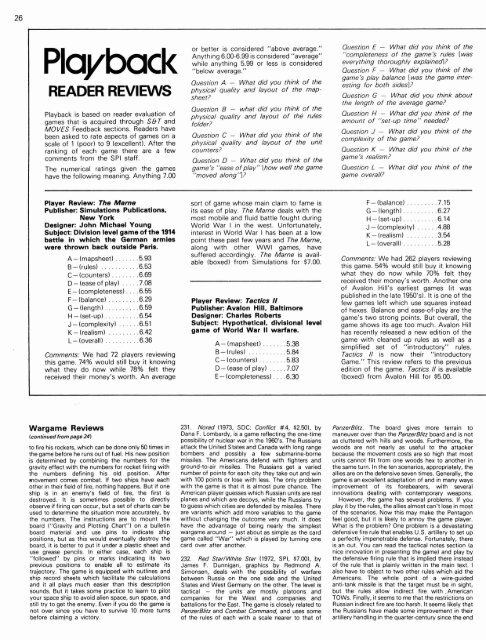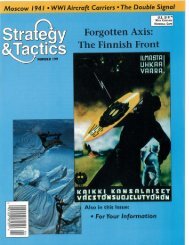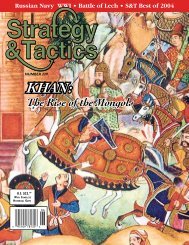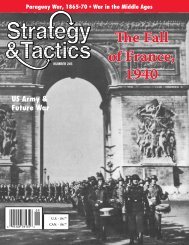the franco-prussian war - Strategy & Tactics
the franco-prussian war - Strategy & Tactics
the franco-prussian war - Strategy & Tactics
Create successful ePaper yourself
Turn your PDF publications into a flip-book with our unique Google optimized e-Paper software.
PlaybackAnythingREADER REVIEWor better is considered "above average,"6.00-6.99 is considered "average"while anything 5.99 or less is considered"below average."Question A - What did you think of <strong>the</strong>physical quality and layout of <strong>the</strong> mapsheet?Question E - What did you think of <strong>the</strong>"completeness of <strong>the</strong> game's rules [waseve~thing thoroughl~ explained?Question F - What did you think of <strong>the</strong>game's play balance [was <strong>the</strong> game interestingfor bothQuestion G - What did you think about<strong>the</strong> length of <strong>the</strong> average game?Question B - what did you rhink of <strong>the</strong>Playback is based on reader evaluation of and of rules Question H - What did you think of <strong>the</strong>games that is acquired through SBT andamount of "set-up time" needed?folder?MOVES Feedback sections. Readers havelhebeen asked to rate aspects of games on a Question C - What did you think of <strong>the</strong>~ : ~ ~ or ~ t ~ ~ . a t ~ ; ~ 2 y 0 uscale of 1 (poor) to 9 (excellent). After <strong>the</strong> physical quality and layout of <strong>the</strong> unitranking of each game <strong>the</strong>re are a few counters? Question K - What did you think of <strong>the</strong>comments from <strong>the</strong> SPI staff. Question D - What did you think of <strong>the</strong> game'The numerical ratings given <strong>the</strong> games game's "ease ofp1ay"Ihow well <strong>the</strong> game Question L - What did you think of <strong>the</strong>have <strong>the</strong> following meaning. Anything 7.00 "moved along'?? game overall?Player Review: The MarnePublisher: Simulations Publications,New York .Designer: John Michael YoungSubject: Division level game of <strong>the</strong> 1914battle in which <strong>the</strong> German armieswere thrown back outside Paris.A-(mapsheet) . . . . . . .5.93B -(rules) . . . . . . . . . . .6.53C- (counters) . . . . . . . .6.69D - (ease of play) . . . . .7.08E - (completeness) . . . .6.55F - (balance) . . . . . . . . .6.29G - (length) . . . . . . . . . .6.59H - (set-up) . . . . . . . . . ,654J - (complexity) . . . . . .6.51K - (realism) . . . . . . . . .6.42Comments: We had 72 players reviewingthis game. 74% would still buy it knowingwhat <strong>the</strong>y do now while 78% felt <strong>the</strong>yreceived <strong>the</strong>ir money's worth. An averagesort of game whose main claim to fame isits ease of play. The Marne deals with <strong>the</strong>most mobile and fluid battle fought duringWorld War I in <strong>the</strong> west. Unfortunately,interest in World War I has been at a lowpoint <strong>the</strong>se past few years and The Marne,along with o<strong>the</strong>r WWI games, havesuffered accordingly. The Marne is available(boxed) from Simulations for $7.00.Player Review: <strong>Tactics</strong> 11Publisher: Avalon Hill, BaltimoreDesigner: Charles RobertsSubject: Hypo<strong>the</strong>tical, divisional levelgame of World War II <strong>war</strong>fare.F - (balance) . . . . . . . . .7.15G- (length) . . . . . . . . . .6.27H - (set-up) . . . . . . . . . .6.14J - (complexity) . . . . . .4.88K - (realism) . . . . . . . . ,354L- (overall) . . . . . . . . . .5.28Comments: We had 262 players reviewingthis game. 54% would still buy it knowingwhat <strong>the</strong>y do now while 70% felt <strong>the</strong>yreceived <strong>the</strong>ir money's worth. Ano<strong>the</strong>r oneof Avalon Hill's earliest games (it waspublished in <strong>the</strong> late 1950's). It is one of <strong>the</strong>few games left which use squares insteadof hexes. Balance and ease-of-play are <strong>the</strong>game's two strong points. But overall, <strong>the</strong>game shows its age too much. Avalon Hillhas recently released a new edition of <strong>the</strong>game with cleaned up rules as well as asimplified set of "introductory" rules.A-(mapsheet) . . . . . . .5.380- (rules) . . . . . . . . . . .5.84 <strong>Tactics</strong> I1 is now <strong>the</strong>ir "introductoryC- (counters) . . . . . . . .5.83 Game." This review refers to <strong>the</strong> previousD -(ease of play) . . . . .7.07edition of <strong>the</strong> aame. <strong>Tactics</strong> I1 is availableE- (completeness) . . . ,630 (boxed) from ivalon Hill for $5.00.Wargame Reviews(continued from page 24)to fire his rockets, which can be done only 50 times in<strong>the</strong>game before he runs out of fuel. His new positionis determined by combining <strong>the</strong> numbers for <strong>the</strong>gravity effect with <strong>the</strong> numbers for rocket firing with<strong>the</strong> numbers defining his old . position. Aftermovement comes combat. If two ships have eacho<strong>the</strong>r in <strong>the</strong>ir field of fire, nothing happens. But if oneship is in an enemy's field of fire, <strong>the</strong> first isdestroyed. It is sometimes possible to directlyobserve if firing can occur, but a set of charts can beused to determine <strong>the</strong> situation more accurately, by<strong>the</strong> numbers. The instructions are to mount <strong>the</strong>board ("Gravity and Plotting Chart") on a bulletinboard material and use pins to indicate shippositions, but as this would eventually destroy <strong>the</strong>board, it is better to put it under a plastic sheet anduse grease pencils. In ei<strong>the</strong>r case, each ship is"followed" by pins or marks indicating its twoprevious positions to enable all to estimate itstrajectory. The game is equipped with outlines andship record sheets which facilitate <strong>the</strong> calculationsand it all plays much easier than this descriptionsounds. But it takes some practice to learn to pilotyour space ship to avoid alien space, sun space, andstill try to get <strong>the</strong> enemy. Even if you do <strong>the</strong> game isnot over since you have to survive 10 more turnsbefore claiming a victory.231. Norad (1973, SDC: Conflict #4, $2.50), byDana F. Lombardy, is a game reflecting <strong>the</strong> one-timepossibility of nuclear <strong>war</strong> in <strong>the</strong> 1960's. The Russiansattack <strong>the</strong> United Statesand Canada with long rangebombers and possibly a few submarine-bornemissiles. The Americans defend with fighters andground-to-air missiles. The Russians get a variednumber of points for each city <strong>the</strong>y take out and winwith 100 points or lose with less. The only problemwith <strong>the</strong> game is that it is almost pure chance. TheAmerican player guesses which Russian units are realplanes and which are decoys, while <strong>the</strong> Russians tryto gtiess which cities are defended by missiles. Thereare variants which add more variables to <strong>the</strong> gamewithout changing <strong>the</strong> outcome very much. It doeshave <strong>the</strong> advantage of being nearly <strong>the</strong> simplest<strong>war</strong>game around - just about as simple as <strong>the</strong> cardgame called "War" which is played by turning onecard over after ano<strong>the</strong>r.232. Red Star/White Star 11972, SPI, $7.00), byJames F. Dunnigan, graphics by Redmond A.Simonsen, deals with <strong>the</strong> possibility of <strong>war</strong>farebetween Russia on <strong>the</strong> one side and <strong>the</strong> UnitedStates and West Germany on <strong>the</strong> o<strong>the</strong>r. The level istactical - <strong>the</strong> units are mostly platoons andcompanies for <strong>the</strong> West and companies andbattalions for <strong>the</strong> East. The game is closely related toPanzerBlitz and Combar Command, and uses someof <strong>the</strong> rules of each with a scale nearer to that ofPanzerBlitz. The board gives more terrain tomaneuver over than <strong>the</strong> PanzerBlitz board and is notas cluttered with hills and woods. Fur<strong>the</strong>rmore, <strong>the</strong>woods are not nearly as useful to <strong>the</strong> attackerbecause <strong>the</strong> movement costs are so high that mostunits cannot flit from one woods hex to ano<strong>the</strong>r in<strong>the</strong> same turn. In <strong>the</strong> ten scenarios, appropriately, <strong>the</strong>allies are on <strong>the</strong> defensive seven times. Generally, <strong>the</strong>game is an excellent adaptation of and in many waysimprovement of its forebearers, with severalinnovations dealing with contemporary weapons.However, <strong>the</strong> game has several problems. If youplay it by <strong>the</strong> rules, <strong>the</strong> allies almost can't lose in mostof <strong>the</strong> scenarios. Now this may make <strong>the</strong> Pentagonfeel good, but it is likely to annoy <strong>the</strong> game player.What is <strong>the</strong> problem? One problem is a devastatingdefensive fire rule that enables U.S. artillery to set upa perfectly impenetrable defense. Fortunately, <strong>the</strong>reis an out. You can read <strong>the</strong> tactical notes section (anice innovation in presenting <strong>the</strong> game) and play by<strong>the</strong> defensive firing rule that is implied <strong>the</strong>re insteadof <strong>the</strong> rule that is plainly written in <strong>the</strong> main text. Ialso have to object to two o<strong>the</strong>r rules which aid <strong>the</strong>Americans. The whole point of a wire-guidedanti-tank missile is that <strong>the</strong> target must be in sight,but <strong>the</strong> rules allow indirect fire with .AmericanTOWS. Finally, it seems to me that <strong>the</strong> restrictions onRussian indirect fire are too harsh. It seems likely that<strong>the</strong> Russians have made some improvement in <strong>the</strong>irartillery handling in <strong>the</strong> quarter-century since <strong>the</strong> end







